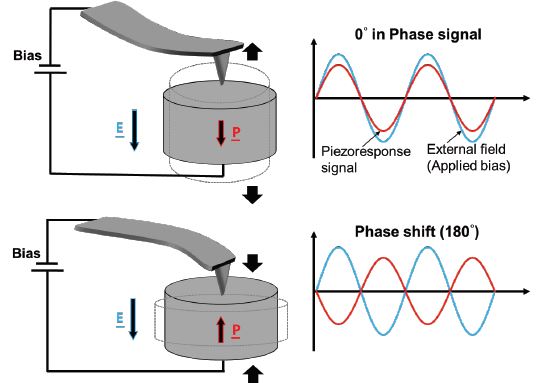
压电力显微镜 (PFM)
纳米尺度上的电机械材料性质以及样品形貌
压电力显微镜(PFM)是一种功能性的原子力显微镜(AFM)模式,它除了能够探测样品的形貌外,还能在纳米尺度上探测材料的电机械性能。当导电探针在接触模式下扫描样品表面时,施加的交流电压会在压电化合物中引发电机械响应,从而解析出压电和铁电性能的局部变化。PFM因其能够提供关于各种材料(包括现代通信技术中的执行器、传感器和电容器)电机械耦合特性的详细信息而越来越受到认可。

压电力显微镜(PFM)是一种功能性的原子力显微镜(AFM)模式,它除了能够探测样品的形貌外,还能在纳米尺度上探测材料的电机械性能。当导电探针在接触模式下扫描样品表面时,施加的交流电压会在压电化合物中引发电机械响应,从而解析出压电和铁电性能的局部变化。PFM因其能够提供关于各种材料(包括现代通信技术中的执行器、传感器和电容器)电机械耦合特性的详细信息而越来越受到认可。
压电力显微镜(PFM)是一种功能性的原子力显微镜(AFM)模式,它不仅能够探测样品的形貌,还能在纳米尺度上探测材料的电机械性能。当导电探针在接触模式下扫描样品表面时,施加的交流电压会在压电化合物中引发电机械响应,从而解析出压电和铁电性能的局部变化。PFM因其能够提供关于各种材料(包括现代通信技术中的执行器、传感器和电容器)电机械耦合特性的详细信息而越来越受到认可。PFM的常见应用包括: • 铁电材料电机械性能的局部表征,包括详细的畴映射和畴切换动力学的研究,这些都可以在材料的铁电迟滞回线中可视化; • 通过解决微纳米电机械器件(如压电执行器、传感器和MEMS)、电光器件以及非易失性存储元件(即FeRAM设备)的可靠性问题(如电机械印记、疲劳和介电击穿),对这些器件进行测试; • 基于详细的纳米尺度结构和电机械特性表征,探索新型聚合物和生物工程材料中铁电极化与其他材料性能之间的局部和全局关系。

图1. PFM的基本原理,铁电畴具有(a)向下极化和(b)向上极化。
本模式说明介绍了压电力显微镜(PFM)的基本原理、仪器设置以及潜在的应用示例。讨论了多个主题,包括图像质量和分辨率的改进、PFM图像中伪影的消除和信息提取,以及压电力力谱学(Piezoresponse Force Spectroscopy),它允许在施加电压下对压电材料响应进行定量分析。在PFM中,导电的AFM探针与铁电或压电材料的表面接触,并在样品表面和AFM探针之间施加预设电压。这个电压在样品内部建立了外部电场。由于铁电或压电材料中存在的逆压电效应,样品会根据电场的方向局部膨胀或收缩。例如,如果探针下方铁电畴的电极化方向与样品表面垂直且平行于施加的电场,则该畴将经历垂直膨胀,如图1(a)所示。由于AFM探针与样品表面接触,这种畴膨胀会使AFM悬臂梁向上弯曲并增加偏转。相反,如果初始畴极化与施加的电场反平行,畴将收缩,导致悬臂梁偏转减小,如图1(b)所示。因此,悬臂梁偏转的变化提供了关于探针下方铁电畴极化方向和相对大小的信息。
然而,畴尺寸的静态变化通常在皮米范围内。为了增加信噪比,PFM在涂有导电材料的探针上施加交流(AC)电压。这个AC电压导致表面以与施加的AC电压相同的频率振动。如果样品畴极化与施加的电场平行,压电样品的响应将与激励同相。如果畴极化与施加的电场反平行,则响应将与激励异相,如图2所示。因此,两个相反方向垂直畴之间的相位差为180°。样品振动的振幅和相位直接作为与表面接触的AFM悬臂梁的偏转信号被检测,并通过锁相放大器读取。

图2. PFM工作原理示意图:样品和导电悬臂梁之间的AC电压引发了样品的周期性压电响应。根据探针下方畴的极化方向,压电响应信号与激励同相或异相180°。

图3. 带有高度信息的PFM振幅和相位图像。
在PFM成像中,交流激励与样品压电响应之间的相位对比直接反映了探针下方畴的极化方向。另一方面,压电响应的振幅则揭示了畴壁的位置。在这里,信号达到最小值,因为两个具有相反极化方向和180°相位对比的畴的响应相互抵消。图3展示了多层陶瓷电容器样品上的PFM振幅和相位图像以及高度图像。当施加+2V的针尖偏压时,PFM信号得到很好的呈现。悬臂梁类型为PPP-EFM(k = 2.8 N/m 和 f = 75 kHz),扫描尺寸为7 μm × 7 μm,像素分辨率为256 × 256,扫描速率为0.2 Hz。

图4. BaTiO3样品表面的AFM形貌图(a)和PFM四象限图(b)。PFM四象限颜色叠加在3D表面形态上的3D叠加图(c),以及PFM四象限图像的线轮廓图(d),显示了畴极化方向。图片来源:土耳其耶迪泰普大学生物医学工程系
图4展示了在复合钛酸钡(BaTiO3)样品上获得的PFM四象限图像的示例,它是PFM振幅和相位的组合。从PFM四象限图像中可以观察到,根据材料类型显示出清晰的对比度,这在高度图像中几乎无法识别。对于包含具有面外和面内取向畴的样品,不仅可以通过跟踪与AFM探针接触的表面的垂直分量,而且可以通过表面平面内不同方向的分量,使用具有垂直和侧向通道的矢量PFM来提供更完整的信息,如图5所示。面外极化是通过跟踪悬臂梁的垂直偏转(即垂直PFM信号)来估计的,而面内极化可以通过悬臂梁的侧向扭转(即侧向PFM信号)来确定。通过使用垂直和侧向PFM信息,可以实现更详细和完整的电机械响应分析。图5展示了铋铁氧体(BiFeO3)样品上的垂直和侧向压电响应。
除了畴成像外,PFM还通过压电力谱学(piezoresponse force spectroscopy)提供了对铁电材料开关特性和动力学的深入了解,该谱学测量了随着探针和样品表面之间额外DC偏压扫描的局部PFM响应。探针下方局部铁电畴的极性根据所施加电压的符号和大小进行排列。图6展示了在锆钛酸铅(PZT)薄膜上PFM振幅与DC电压的滞后回线和PFM相位与DC电压的滞后回线。这个相位滞后回线揭示了极化方向随施加DC电压的变化。随着电压逐渐增加,畴在约0.8 V和3.1 V时分别出现大约180°的反转。在压电力谱学中,用户可以在不同位置执行一系列PFM信号与电压的谱学测量。这些谱学提供了关于铁电畴局部开关行为的信息。

图5. 展示了由于面外和面内压电响应信号分别导致的悬臂梁垂直和侧向偏转和扭转的示意图(a)。在铋铁氧体(BiFeO3)样品上的垂直和侧向PFM振幅和相位图像。
On ferroelectric samples, PFM can be combined with Nanolithography (see “Nanolithography mode note” for more information) to tailor customized domain patterns on the nanometer scale. Here, the application of positive or negative DC voltages to the tip can change the polarization of vertical ferroelectric domains by 180°. Figure 7 shows the Nanolithography PFM capability on a PZT film surface by writing the Park Systems logo via DC bias application and a subsequent PFM scan to image the logo on the PFM amplitude and phase. To write the logo on the ferroelectric surface +10 V tip bias was applied to the dark areas of the lithography design in figure 7 (a) and -10 V was applied to the bright areas of the design to switch the domain orientation in the opposite direction for the background of the logo. After writing the domain pattern on the PZT film, the PFM amplitude clearly imaged the domain walls, while the PFM phase showed the opposite domain orientations between the Park Systems logo and the background in figure 7 (b) and (c).

图6. PZT薄膜样品上的代表性压电力谱学测量,用于局部测量铁电滞后曲线。(a) PZT薄膜的AFM高度图,绿色十字指示了谱学测量的位置。(b) PFM振幅与电压曲线。(c) PFM相位与电压曲线。

图7. 通过铁电开关在PZT薄膜上进行纳米光刻设计以形成畴结构。(a) 纳米光刻设计图,用于在PZT薄膜上形成畴结构。在写入过程中,设计图中的暗区域应用正+10 V DC偏压,亮区域应用负-10 V偏压。(b) 根据设计切换畴后的PFM振幅图。(c) 根据设计切换畴后的PFM相位图。